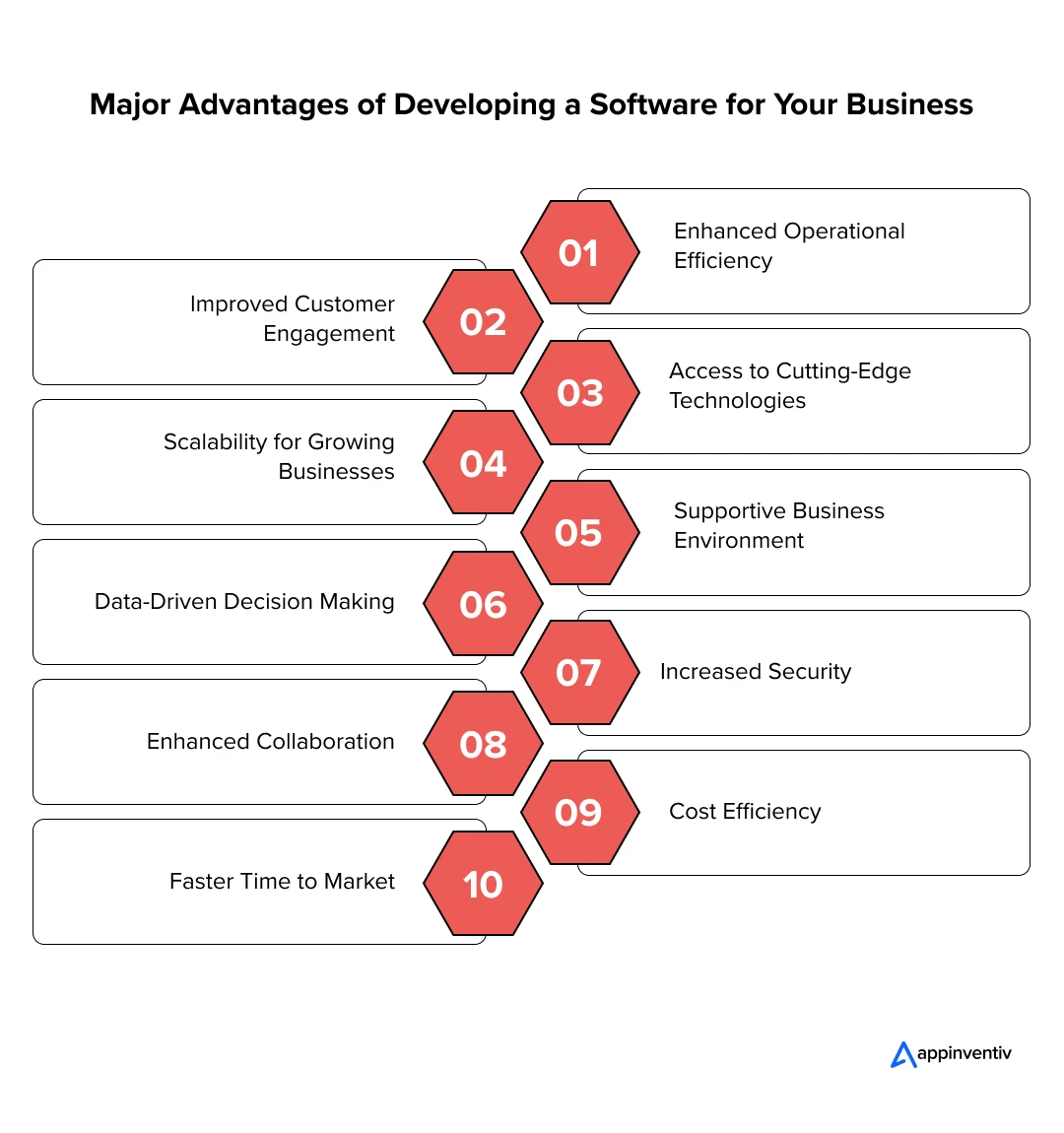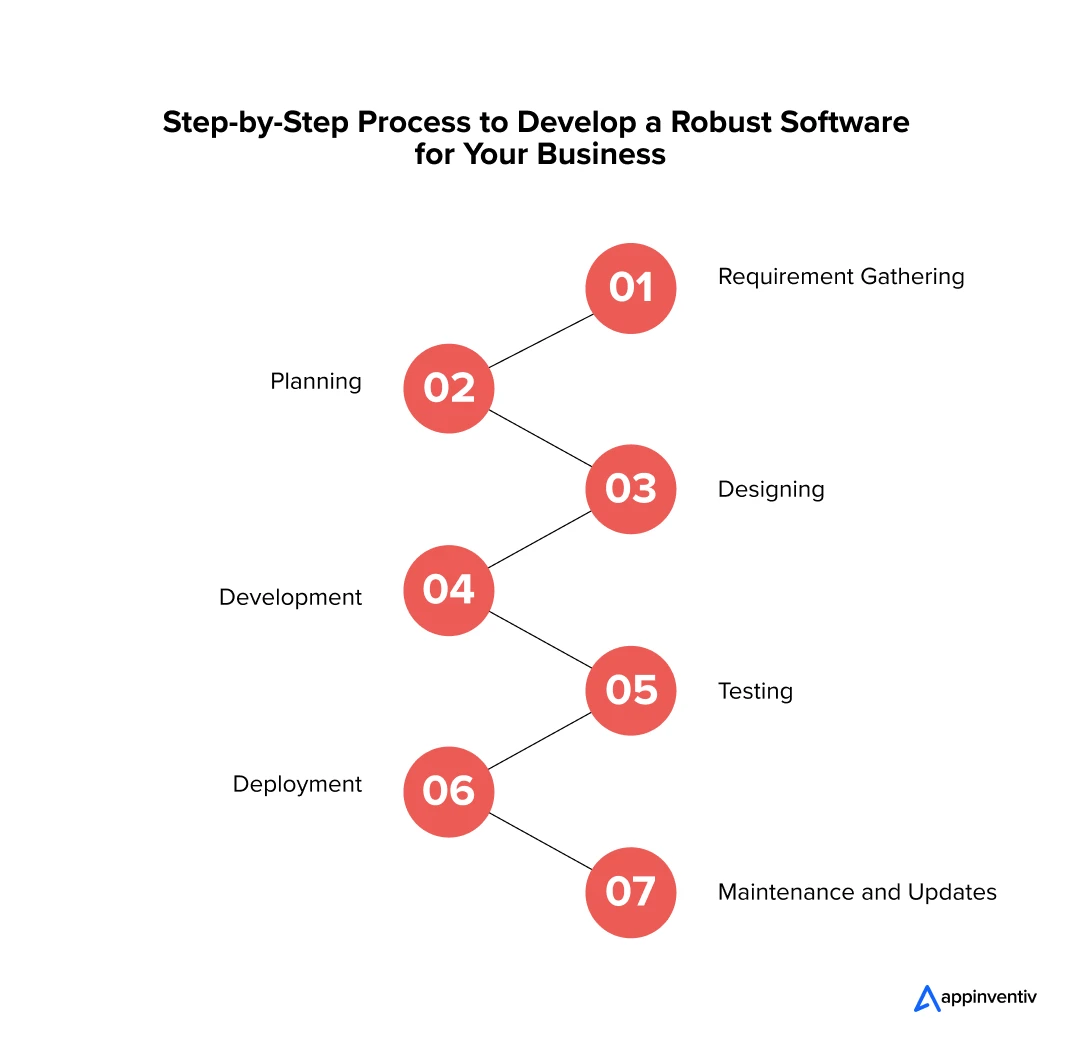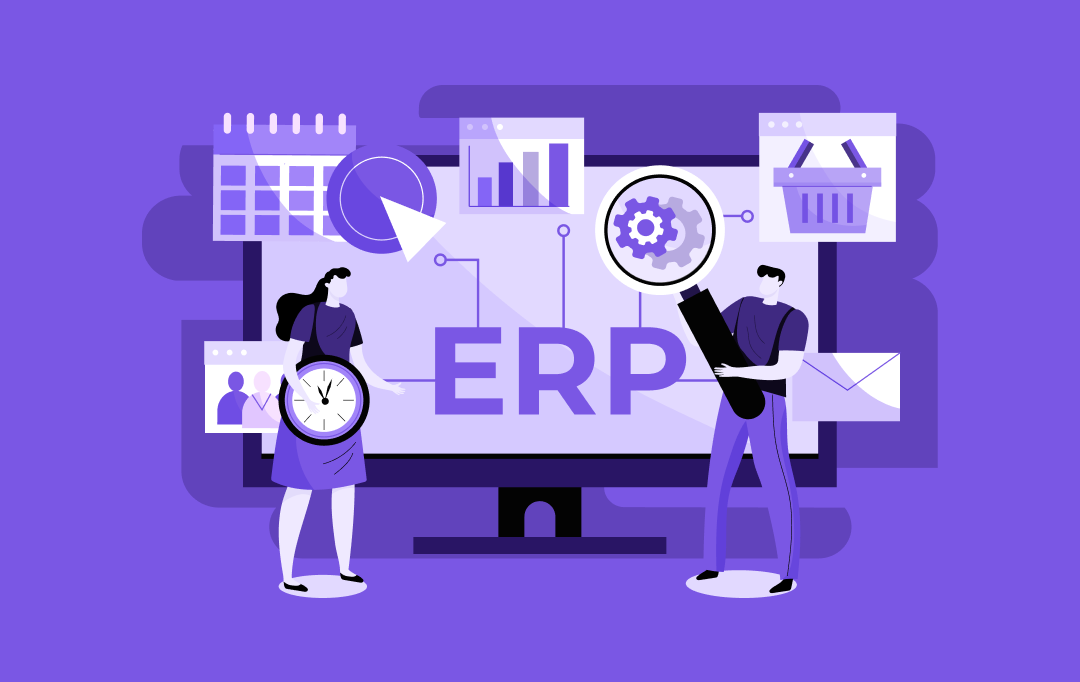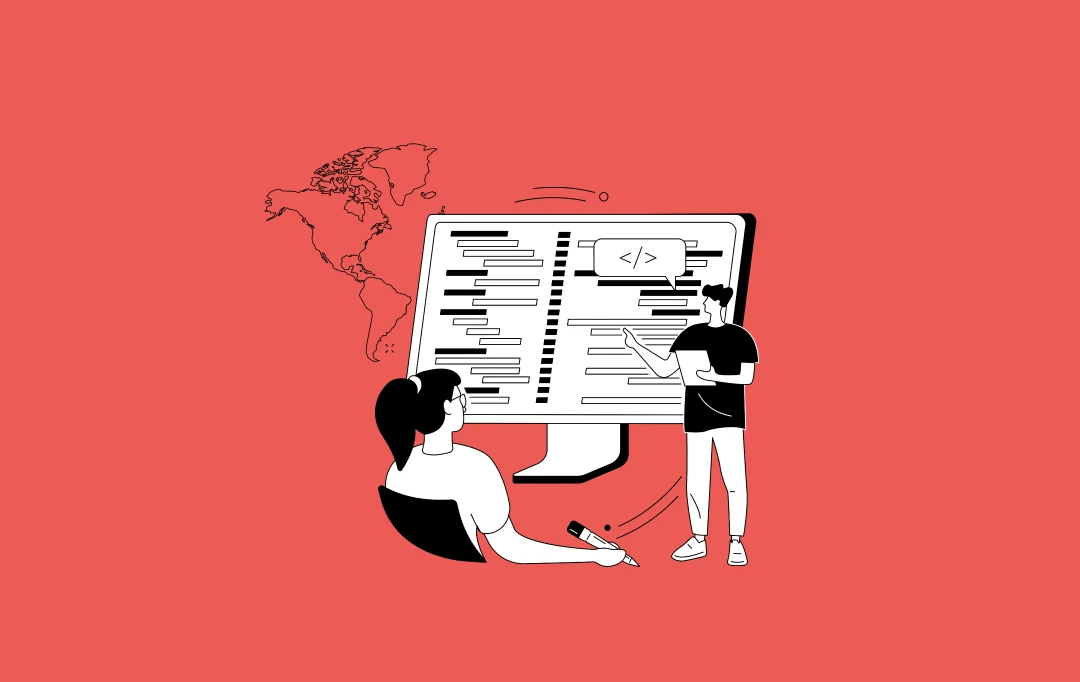- Understanding the Software Development Market in the Middle East: What's Hot and What's Not?
- Why Should Businesses Adopt Custom Software Development? Key Benefits
- Enhanced Operational Efficiency
- Improved Customer Engagement
- Access to Cutting-Edge Technologies
- Scalability for Growing Businesses
- Supportive Business Environment
- Data-Driven Decision Making
- Increased Security
- Enhanced Collaboration
- Cost Efficiency
- Faster Time to Market
- Use Cases of Software Development in the Middle East Region
- Healthcare: Enhancing Patient Care and Efficiency
- Financial Services: Ensuring Transaction Security and Efficiency
- Retail: Streamlining Operations and Personalizing Shopping
- Food Delivery: Enhancing Efficiency and Customer Satisfaction
- Oil and Gas: Boosting Operational Safety and Efficiency
- Smart Cities: Enhancing Urban Efficiency
- eCommerce: Streamlining Online Shopping and Inventory Management
- Construction: Enhancing Project Management and Efficiency
- Education: Facilitating Learning and Management
- Tourism and Hospitality: Elevating Guest Experiences and Management
- How Appinventiv Middle East Helped IKEA with a Custom ERP Software Solution That Is Touted as Its Biggest Source of RoI Measurement
- How to Develop a Robust Custom Software for Your Business: Understanding the Software Development Process in the ME
- 1. Requirement Gathering
- 2. Planning
- 3. Designing
- 4. Development
- 5. Testing
- 6. Deployment
- 7. Maintenance and Updates
- How Much Does it Cost to Develop Software in the Middle East?
- Software Complexity
- Features and Functionalities
- Technology Stack
- Security and Regulatory Compliance
- Location of the Development Team
- UI/UX Design
- Maintenance and Updates
- Integration with Existing Systems
- Why Appinventiv is the Best Software Development Partner to Leverage the Growing Tech Ecosystem in the Middle East
- FAQs
Once known as a region reliant only on the oil and gas industry to drive its economy, the Middle East is now one step ahead of the rest of the world when it comes to digital transformation. And what’s the major reason driving this cause? Well, it’s software development that is quickly gaining momentum in the country, emerging as vital areas for economic diversification and innovation.
This shift towards software development in the Middle East is supported by the region’s strategic geographic position and its increasingly tech-savvy population, which makes it one of the most appealing hubs for businesses looking to modernize and seek new opportunities for growth.
The rise in software development in areas like the UAE, Qatar, Saudi Arabia, etc, is not just about adopting new technologies but about optimizing business processes, elevating customer support, and introducing advanced service delivery approaches that were previously unseen in the region. These progressions boost efficiency and lay the groundwork for significant economic changes throughout the Middle East.
According to the reports, the SaaS industry in the Middle East is expected to reach a valuation of $22.7 billion by 2030, witnessing a CAGR of 18.25% from 2023 to 2030. The increasing market share can be attributed to the region’s significant commitment to embracing digital transformation.
In this blog, we will dive into the benefits of software development in the Middle East, including specific use cases, the development process, and the costs involved. Whether you are a startup looking to push your business from the ground up or an established enterprise looking to scale, understanding how to leverage software development here can be crucial for tapping into new markets and driving growth.
Understanding the Software Development Market in the Middle East: What’s Hot and What’s Not?
Are you one of the businesses looking to expand your horizons and tap into new markets? Well, the Middle East’s rapidly evolving software development sector may be the key to unlocking new opportunities for growth and innovation.
Over the past few years, this region has transformed into a thriving technology hub, making it an exciting prospect for businesses eager to leverage cutting-edge software solutions. The transformation has been fueled by significant increases in venture capital, which was valued at around $16 billion in June 2023, and has skyrocketed as investors seek to capitalize on the region’s growing technology explosion. This influx of capital is a sign of confidence in the region’s tech potential and a direct contributor to the rapid development and adoption of new technologies.
Among these technologies, Artificial Intelligence (AI) is particularly transformative. Businesses across the Middle East are increasingly employing AI to streamline operations, enhance decision-making, and improve customer interactions. AI’s capabilities are further being harnessed to drive efficiency and innovation across various sectors. This widespread adoption of AI underscores the Middle East’s commitment to securing a leading position in the global digital economy.
According to a BCG report, 93% of CIOs in the Middle East have expressed interest in investing in AI and Gen AI in the year 2024 and are likely to integrate these technologies in their tech vision for the future. In addition to this, some of the other technologies that are bound to take the future of software development in the Middle East up by storm include the likes of blockchain, cloud computing, and the Internet of Things (IoT). These technologies are set to redefine the way businesses operate, offering enhanced security, scalability, and connectivity.
Now, before diving into the use cases of these industries in the Middle East software development ecosystem, let’s take a quick look at the benefits of software development for your business, which are explained in detail below.
Why Should Businesses Adopt Custom Software Development? Key Benefits
Software development in the Middle East offers a range of benefits that can significantly enhance your business operations and market presence. Here’s a closer look at how your business can gain from investing in custom software solutions:

Enhanced Operational Efficiency
Software development significantly streamlines business operations. Custom software solutions can automate repetitive tasks, minimize errors, and ensure smoother and more efficient processes. This efficiency not only saves time but also helps in reducing long-term operational costs.
Improved Customer Engagement
Software tools enhance how businesses connect with their customers by providing personalized communication, responsive support systems, and user-friendly interfaces. This level of improved engagement paves the way for stronger relationships with customers, boosting loyalty and encouraging retention.
Access to Cutting-Edge Technologies
The Middle East’s growing tech sector provides businesses with access to the latest innovations in software development, such as AI, blockchain, and cloud computing. Utilizing these technologies gives companies a competitive advantage, enabling them to offer distinctive services and better meet their customers’ needs.
[Also Read: Integration of AI and Blockchain: All You Need to Know]
Scalability for Growing Businesses
Custom software solutions are built with scalability in mind, allowing businesses to expand without being limited by their tech infrastructure. As a business grows, its software can be easily adjusted and scaled to meet new demands without continuous large investments.
Supportive Business Environment
The region’s business-friendly policies, financial incentives, and robust IT infrastructure make it easier for companies to adopt and integrate new software solutions. This supportive setting makes it simpler for businesses to adopt and integrate new software solutions effectively.
Data-Driven Decision Making
Software development in the MENA regions as well as other areas empowers businesses to leverage data analytics, enabling them to collect, analyze, and act on data insights. This helps companies make informed decisions, identify trends, and predict customer behaviors, leading to strategic planning and improved outcomes.
Increased Security
As cybersecurity threats increase, software with advanced security features is crucial for protecting businesses from data breaches and cyber attacks. This ensures the safety of sensitive information and maintains customer trust, which is essential for business reputation.
Enhanced Collaboration
Modern software development often comes with tools that enhance communication and teamwork among employees, regardless of their location. Thus, getting services related to software development in the Middle East leads to greater productivity and efficiency as teams can collaborate seamlessly and access shared resources in real time.
Cost Efficiency
Although the initial investment in software development can be substantial, the long-term savings are significant. Automating processes and minimizing manual intervention reduce operational costs, and cloud-based solutions can cut down on IT infrastructure and maintenance expenses.
Faster Time to Market
Software that automates and streamlines processes can drastically reduce the time it takes for businesses to bring their products and services to market. This rapid deployment is a key advantage in today’s competitive market, helping companies stay ahead of their competitors and capitalize on new opportunities quickly.
Use Cases of Software Development in the Middle East Region
Software development is revolutionizing various industries in the Middle East, enhancing operations and customer experiences. Here’s how different sectors are leveraging technology:
Healthcare: Enhancing Patient Care and Efficiency
The healthcare sector is leveraging software development to enhance patient care and streamline operations. Digital health records simplify data management, ensuring that patient information is easily accessible and secure. Telemedicine software further expands healthcare services to remote areas, minimizing the need for in-person visits and facilitating prompt medical consultations. In addition to this, healthcare crm software development helps manage patient interactions more effectively, improving communication between patients and healthcare providers and ensuring that each patient receives personalized care and attention.
For example, Cleveland Clinic Abu Dhabi has effectively integrated digital health records and telemedicine into its healthcare services, significantly enhancing patient management and care. By using digital health records, the clinic ensures that all patient information, from medical history to treatment plans, is updated in real-time and accessible to healthcare professionals across different departments.
Financial Services: Ensuring Transaction Security and Efficiency
The financial sector is harnessing software development to secure transactions and enhance customer service among other things. By integrating blockchain technology, businesses ensure transparent and secure financial operations, while AI-powered FinTech systems streamline customer interactions, making services more efficient and responsive.
For instance, First Abu Dhabi Bank (FAB) has integrated blockchain to secure its transactions and employs AI to customize and improve customer service. Using AI, the bank offers personalized banking advice and automates routine inquiries, elevating the customer experience and operational efficiency.
Retail: Streamlining Operations and Personalizing Shopping
Retail is one of the major use cases of software development in the Middle East that has made its mark in the region. The retail industry benefits immensely from software that personalizes customer experiences and optimizes inventory management. AI-powered retail software solutions have the power to analyze consumer behavior to tailor marketing strategies and manage stock levels effectively.
[Also Read: How Can Mobile Apps Add Value to Your Retail Business?]
For example, Y.K. Almoayyed & Sons, a prominent player in the Middle East retail industry, significantly improved its operations by upgrading its software infrastructure with our cloud solutions. We implemented Amazon Web Services (AWS) to ensure greater system availability, scalability, and security, enhancing their ability to support diverse business operations. This transformation helped them modernize their existing systems while offering them a foolproof way to handle future expansions seamlessly.

Food Delivery: Enhancing Efficiency and Customer Satisfaction
Software development is crucial for optimizing order processing, delivery tracking, and customer interaction in the food delivery industry. These platforms allow for real-time order updates and route optimization for delivery personnel, leading to faster delivery times and increased customer satisfaction.
For instance, we helped the world’s largest fast food giant, KFC, revamp its digital presence across the Middle East by launching 7+ mobile apps. Our collaboration with the brand helped them increase their conversion rates by 22%, witness a 60% increase in repeat purchases, and generate 100% revenue upliftment during peak holiday season.
Oil and Gas: Boosting Operational Safety and Efficiency
Software solutions are pivotal in the oil and gas industry for improving safety and efficiency. Advanced AI-powered monitoring systems equipped with predictive analytics capabilities play a crucial role. These systems can accurately forecast potential equipment malfunctions before they occur, allowing for proactive maintenance and avoiding unplanned downtime that can be costly and dangerous. This proactive approach not only safeguards the equipment but also ensures the safety of the workforce by preventing accidents and environmental hazards.
For instance, Saudi Aramco uses software to automate and monitor its operations, significantly reducing the risk of unplanned downtimes. These systems provide real-time data that help in making informed decisions, thereby enhancing operational efficiency and safety across all levels of the organization.
Smart Cities: Enhancing Urban Efficiency
Software development in the Middle East is also crucial when it comes to smart city initiatives, where it improves traffic management, energy use, and public services. IoT software efficiently controls traffic lights and energy systems, making urban living more sustainable.
For example, Neom, a planned city in Saudi Arabia, is being designed from the ground up as a smart city. Neom is set to utilize a wide array of IoT software and other advanced technologies to automate everything from traffic management to energy systems and public services.
Now that you have looked into the major use cases of software development in the Middle East, let’s offer you a quick insight into how we helped the world’s major furniture brand IKEA in revamping its operations in the ME region.
eCommerce: Streamlining Online Shopping and Inventory Management
The eCommerce sector greatly benefits from software that provides seamless shopping experiences and efficient inventory management. AI and data analytics are used to predict buying trends, recommend products, and manage stock levels effectively.
For example, Adidas enhanced its mobile presence in the Middle East by partnering with us to develop a dedicated software solution tailored to the regional market’s needs. We developed and launched a dedicated solution, adhering to their branding guidelines and adding multi-lingual and multi-currency features to appeal to a diverse audience. This move greatly expanded Adidas’s reach, resulting in over 2 million downloads and 500,000 new users, enhancing its overall digital presence in the region.

Construction: Enhancing Project Management and Efficiency
The construction industry in the Middle East is also transforming through the integration of advanced software solutions that aims to enhance project management as well as operational efficiency. These digital tools facilitate better planning, management and execution of construction projects, ensuring timely delivery and reduced costs.
For example, construction of the iconic Jeddah Tower heavily relies on sophisticated software to manage its complex logistics and construction phases. This integration of technology not only speeds up the construction process but also ensures adherence to safety and quality standards
Education: Facilitating Learning and Management
Educational institutions are utilizing software development to transform both learning experiences and administrative operations. Platforms that support online learning and classroom management allow schools to offer flexible, interactive educational experiences.
For instance, the American University of Sharjah has leveraged advanced software solutions to enhance both learning and administrative processes. The university uses a comprehensive management system that integrates student information, course content, and communication tools, making it easier for both students and faculty to engage effectively.
Tourism and Hospitality: Elevating Guest Experiences and Management
Software development is key to enhancing guest experiences and streamlining property management in the tourism and hospitality industry. Integrated management systems allow hotels to offer personalized services, from check-in to dining experiences.
For example, Empire Hotel, in collaboration with Appinventiv Middle East, revolutionized its service delivery by integrating cryptocurrency into its operations through the Empire software solution. This innovative project eliminated the need for intermediary hotel booking services, making the booking process more transparent and cost-effective for guests. The software allows for direct bookings through a blockchain platform, removing unnecessary fees and enabling the hotel to pass these savings directly to the customers.

[Also Read: Redefining Mobile App Development Success in the Middle East – 6 Business Case Studies]
How Appinventiv Middle East Helped IKEA with a Custom ERP Software Solution That Is Touted as Its Biggest Source of RoI Measurement
Appinventiv developed a custom ERP software solution for IKEA, one of the world’s largest furniture retailers, to enhance the shopping experience for its walk-in customers. This solution allowed customers to access the store’s product catalogs directly from tablets placed throughout the store. In addition to helping the customers with an in-store catalog, the solution also helped the brand with its marketing initiatives.
We began by mapping the customer journey to understand the challenges faced by IKEA’s in-store customers. This helped define the necessary features and integration requirements for the ERP solution.
The ERP solution has now been implemented in over 7+ IKEA stores in the UAE, proving to be a significant return on investment for the retailer. This initiative by Appinventiv not only streamlined the brand’s operations but also supported its goals of enhancing customer service and boosting marketing efficacy.

How to Develop a Robust Custom Software for Your Business: Understanding the Software Development Process in the ME
Developing robust custom software for your business involves a series of strategic steps designed to ensure the final product effectively meets your needs. As a renowned company offering robust custom software development in Saudi Arabia, here’s a straightforward guide to our software development process in the ME:

1. Requirement Gathering
This initial stage is all about understanding what you need from the software. It involves detailed discussions with stakeholders within your company to determine the software’s goals, functionality, and the problems it needs to solve. Clear communication at this stage lays a solid foundation for the development process.
2. Planning
Once the requirements are clear, the next step for the software engineers in the Middle East is to plan how the software will be developed. This includes deciding on the technologies to be used, the software architecture, and designing the user interface. The plan should outline the project timeline, resources needed, and milestones to track progress.
3. Designing
During this stage, UI/UX designers collaborate closely with developers to create intuitive and visually appealing interfaces. They also construct the overall framework of the software, ensuring it is user-friendly and aligns with the business objectives outlined in the requirement gathering phase.
4. Development
With a plan in place, software developers begin coding according to the design specifications. This is where the software starts to take shape. Developers write code, integrate databases, and ensure the software functions as intended.
5. Testing
Testing is crucial to ensure the software works correctly and is free of bugs. The testers run various tests, including functionality testing, performance testing, and security testing, to verify that the software meets all specified requirements and operates smoothly.
6. Deployment
Once testing is complete and the software is bug-free, it’s deployed in the desired environment. This is where the software is initially made available to a select group of users, or a full deployment is carried out, depending on the business strategy and risk assessment.
7. Maintenance and Updates
Software development doesn’t end with deployment. To keep the software up-to-date and running efficiently, regular maintenance is required. This includes updating the software to add new features, fixing any issues that arise, and improving performance as technology evolves.
[Also Read: Custom Software Development – An Ultimate Guide for 2024]
How Much Does it Cost to Develop Software in the Middle East?
Software development in the UAE can be a significant investment for any business aiming to enhance its operations or expand its market reach. The overall software development cost in the Middle East or the UAE varies widely depending on its overall complexity and the features that are integrated in it.
To give you a rough idea, the costs might vary from $40,000 to $300,000 and beyond, depending on factors like chosen technology stack, UI/UX design, location of the hired software development team, and regulatory compliance.
Let’s look at the breakdown of factors that influence the cost of software development in the Middle East in detail below:

Software Complexity
The complexity of software plays a significant role in determining development costs. Basic software with simple functionalities generally costs less, while complex software requiring advanced algorithms, real-time processing, or extensive system integrations incurs higher expenses.
Features and Functionalities
The number and intricacy of features significantly influence software costs. Complex features such as user authentication, interactive dashboards, machine learning, and third-party integrations demand more development time and resources, increasing overall costs.
Technology Stack
Choosing the right technology stack is important because it influences how well the software can grow in the future. More advanced or specialized technologies usually cost more than more common solutions.
Security and Regulatory Compliance
If your software deals with sensitive information or financial transactions, following compliance requirements like data protection laws often means investing in additional security measures. These measures include advanced encryption, secure data storage, regular security audits as well as compliance checks as per the local and international standards. Ensuring that your software is compliant as per the rules and laws not only protects you from legal issues but also builds trust with your users.
[Also Read: Digital Immune System – How it Shields Your Business Against Cyberattacks]
Location of the Development Team
The location of your development team can significantly impact the cost of software development in the Middle East. For example, hourly rates of development in areas like the UK or the US are usually higher than in regions like Asia. In addition to this, costs also vary depending on whether you use an in-house team, hire freelancers, or outsource to a development agency.
UI/UX Design
Good UI/UX design is essential for making sure the software is easy to use. The cost of design can increase if the software requires custom graphics or more.
Maintenance and Updates
Keeping software up-to-date and running smoothly after it’s launched is essential. This includes fixing bugs and updating the software for new operating systems. These maintenance tasks are necessary but can add to the overall software development cost in the Middle East.
[Also Read: What is the Cost of Maintaining an App in 2024?]
Integration with Existing Systems
If the software needs to work with your current IT systems, the costs can be higher due to the complexity of making sure everything works together smoothly. This often requires the software developers in the Middle East to create custom APIs and carry out extensive testing.
Let us now try and offer you a brief estimate on the overall costs to develop multiple types of software:
| Type of Software | Features | Estimated Software Development Cost in the Middle East |
|---|---|---|
| Healthcare Software | Patient record management, telemedicine, scheduling | $180,000 to $300,000 (AED 660,600 to AED 1,101,000) |
| Financial Software | Transaction security, compliance, reporting | $100,000 to $200,000 (AED 367,000 to AED 734,000) |
| Retail Software | Inventory management, customer engagement, POS | $60,000 to $120,000 (AED 220,200 to AED 440,400) |
| eCommerce Software | Shopping cart, payment gateway, customer analytics | $70,000 to $150,000 (AED 256,900 to AED 550,500) |
| Educational Software | Course management, virtual classrooms, assessments | $50,000 to $100,000 (AED 183,500 to AED 367,000) |
| Tourism Software | Booking system, customer management, reviews | $90,000 to $180,000 (AED 330,300 to AED 660,600) |
| Real Estate Software | Property listings, CRM, virtual tours | $80,000 to $160,000 (AED 293,600 to AED 587,200) |
| Logistics Software | Route optimization, inventory tracking, dispatch | $100,000 to $200,000 (AED 367,000 to AED 734,000) |
Why Appinventiv is the Best Software Development Partner to Leverage the Growing Tech Ecosystem in the Middle East
Appinventiv stands out as a leading software development partner with a proven track record of success across multiple industries. Our extensive experience in developing innovative custom software solutions enables us to provide our clients with cutting-edge, scalable, and efficient software that drive business growth.
Whether you are a startup or an established enterprise, our team of experts leverages the latest technologies to create software that not only meets but exceeds your expectations. As a software development company in Dubai and other parts of the MENA region, our expertise further spans across a diverse range of sectors including healthcare, finance, retail, and more, giving us the unique ability to understand the specific software development challenges and needs of each industry.
We have collaborated with some of the prominent names in the MENA region including the likes of KFC, Americana Group, IKEA, Pizza Hut, 6th Street, Adidas and more, demonstrating our ability to deliver high-quality and impactful digital solutions that cater to diverse industrial needs.
We further employ agile methodologies to ensure that projects are delivered on time and within budget, all while maintaining the flexibility to adapt to changes and new requirements as they arise. Additionally, as one of the most renowned software development companies in the Middle East, our deep industry knowledge allows us to tailor solutions that are perfectly aligned with our client’s business goals.
Let Appinventiv help you leverage the growing tech ecosystem to position your business at the forefront of your industry. Contact us today!
FAQs
Q. How much does it cost to build software in the UAE?
A. The overall software development cost in the Middle East or the UAE can vary widely depending on factors such as the complexity of the software, the technology stack used, the number and complexity of features, and the development team’s location.
Simple software might start around $40,000, while more complex software could go up to $300,000 or more. Additional costs related to software development in the Middle East can also arise from the need for custom UI/UX designs, integration with existing systems, ongoing maintenance, updates, and compliance with regulatory standards.
Q. How long does it take to build software in the Middle East?
A. The duration to develop software in the Middle East depends on several factors, including the project’s scope, software complexity, and the methodologies employed by the development team. A simple software project might take 3-6 months, while a more complex one could take nine months to a year or longer.
Q. How do you choose one of the best software development service providers in the Middle East for your business?
A. When choosing a provider for software development in the MENA, consider these key factors:
- Experience and Expertise: Find a provider with a strong track record in your industry and the right technical know-how.
- Portfolio and Case Studies: Look at their previous work to understand their capabilities and the quality they offer.
- Client Testimonials and References: Feedback from past clients can reveal a lot about their dependability, responsiveness, and more.
- Development Methodology: Make sure the software development company in the Middle east has an approach to develop the software that matches your project needs and business style.
- Support and Maintenance: Verify if they offer ongoing support and maintenance after the software is launched.
Cost Efficiency: Ensure their prices are competitive and provide good value without sacrificing software quality.


- In just 2 mins you will get a response
- Your idea is 100% protected by our Non Disclosure Agreement.

Custom Development or White Label Solutions: Which is Right for Your Business?
Key takeaways: 77% of companies are prioritizing digital transformation; the right tech approach is crucial for staying competitive. Custom development offers tailored solutions for unique needs, flexibility, and long-term scalability. Whereas, white-label solutions provide quick market entry, cost-efficiency, and easy customization for standard needs. Appinventiv’s expertise helps you navigate custom development vs white-label to choose…

ERP Integration in Australia - Why It Is Essential and How to Do It Right
Key takeaways: ERP integration enables operational efficiency, reduced costs, and enhanced decision-making. Healthcare, finance, manufacturing, retail, and all the other sectors are benefiting from ERP integrations in Australia. While ERP integration can be costly, ranging from AUD 45,000 - AUD 450,000, it leads to significant long-term savings and scalability. Compliance with Australian regulations is critical,…

Predictive Analytics Software Development - Features, Benefits, Use Cases, Process, and Cost
Key Takeaways Predictive analytics helps businesses shift from “what has happened” to "what will happen," enabling proactive strategies rather than reactive ones. Real-time analytics and AI integration are driving the growth of predictive analytics, making it more accurate, accessible, and critical for business success. Custom predictive analytics solutions can enhance customer satisfaction, reduce costs, and…


















